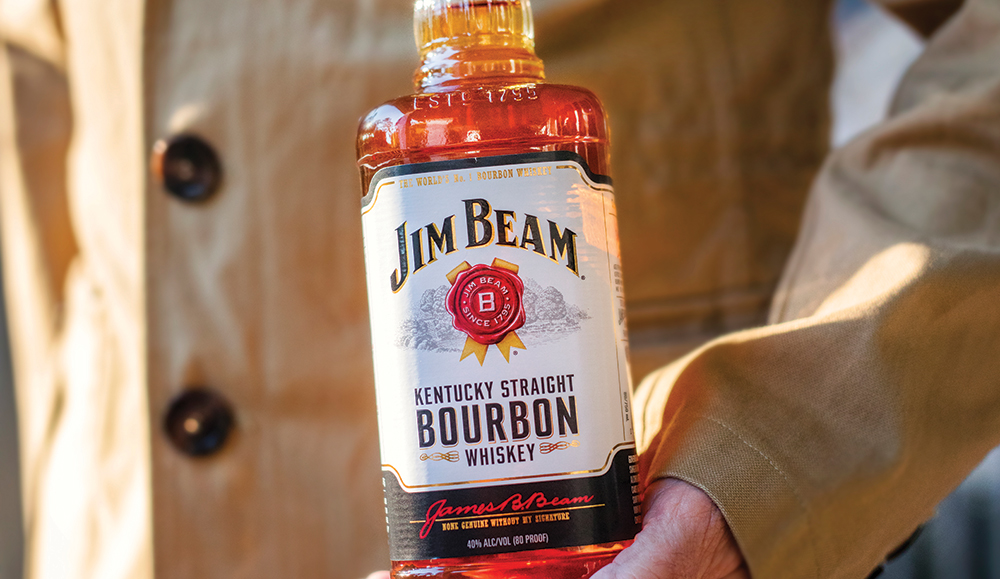A Love Affair with Jim Beam
Revisiting my first legal drink of Jim Beam White Label
Article by Fred Minnick
The backpack snugged firmly against my shoulders, I walked the winding Oklahoma State campus sidewalks, skipped up the stairs, and raced to my room, where a bottle of Jim Beam White Label awaited me. It was my 21st birthday, and friends awaited me to do grown-up things. You know, the kind you can do when you turn 21? (Of course, I participated in no such “things” prior to this date.)
The sun had just set, an orange-and-blue Oklahoma skyline shimmered upon the Delta Chi House, and I leaned against the balcony with a red Solo cup in hand and looked at the horizon. “Wow,” I thought, appreciating the moment, “I’m 21.”
I kicked the red Solo cup back and proceeded to have an unforgettable night. That was the moment of my first legal sip of whiskey. I knew not the flavor of bourbon then, the pronounced grain and hints of caramel that lived inside Beam’s entry-level bourbon. I didn’t know it was four years old, distilled by the great Booker Noe or Baker Beam, or that Beam was an iconic and historic brand. All I knew: It was smooth, a word you used for the spirit not burning.
Since that eventful night, I’ve dedicated my career to sipping good drink, but whenever I see a bottle of Jim Beam White Label in all its 80-proof glory, I remember my first sip and am immediately connected to a time when my knees worked better, I had more hair, and there wasn’t this damn spare tire following me everywhere I went.
Recently, I was called upon to professionally review Jim Beam White. Now, I won’t lie: I don’t regularly drink Jim Beam White. It’s grain-forward and lacks complexity, but it’s wonderful in a pinch, remains smooth, and offers nostalgia, so I’ll sip it on airplanes, in theaters, and other places where it’s the only option. But if I have a choice, Beam’s usually losing to something else with a little more meat on the bone.

For the review, I poured two fingers neat into my Glencairn glass and took in the bouquet. A blast of grain comes forth on the nose, while subtle oak and sweetness marks the taste. Not bad. I scored it an 80 for Whisky Advocate. It’s not my lowest score and it’s around what I had expected, but professionally tasting it dulled my beloved memory of that first sip so long ago.
Back then, you could have poured me Pappy Van Winkle with Coca-Cola, and I wouldn’t know better. I simply didn’t have a discerning palate then.
That review also made me think of my son, a strong-willed three-year-old who gives me tasting notes on his pineapple juice. Geez, where did he learn that? What will he taste at his first legal opportunity? I hope his palate is ready for something I have locked away—perhaps one of the best Pappy releases of all time, a Michter’s Celebration, or 1940s-era Stitzel-Weller. Or will he, as I did, prefer the company of his friends and something good and cheap?
To most, the first drink conversation with a kid probably surrounds trepidation, emergency phone numbers, and “don’t you dare get behind a wheel.” I’ll surely cover the responsibility factors, but will he choose the right bourbon (better not be vodka!) or rum to suit his young palate?
And therein lies the operative question that rekindles my love affair with Jim Beam White Label. When I was 21, my palate was as refined as what I ate—potato chips and ramen noodles. As we grow and our taste buds develop, we crave higher-quality food and drink. Oh sure, I still enjoy potato chips (high-end kettle ones) and ramen (from my favorite Korean restaurant), but I require a bit more depth in my whiskey than I did at 21.
So I revisited my collegiate whiskey again. No notepad. No scoring sheet. Just my glass and me. This time, as I sip, I’m reminded of my former self and for a moment I’m 21 again, with my whole life ahead of me and the ability to run a six-minute mile. Then, my professional palate kicks in, picking up the grain, the oak, and the whiskey’s youth, but this time the true reality sets in: I’m living the dream, and Beam is still smooth.
Hey, maybe my palate wasn’t so bad at 21, after all.





